The ‘Beyond Meat’ craze seems to be popping up everywhere these days. From A&W’s launch of the Beyond Meat burger last year to Tim Horton’s recent introduction of a Beyond Meat ‘sausage’ patty in their breakfast sandwich, it is hard to go a day without seeing some type of promotion for these products.
The Beyond Meat IPO was hugely successful and the stock has run from $25/share at the initial IPO price to an intraday peak at around $200/share in the following 8 weeks since going public. In my experience, when a stock has a stratospheric run up, it is likely to also have a similar path back down to earth. Short sellers have also jumped on the stock with over 9% of the shares now shorted. See chart below:
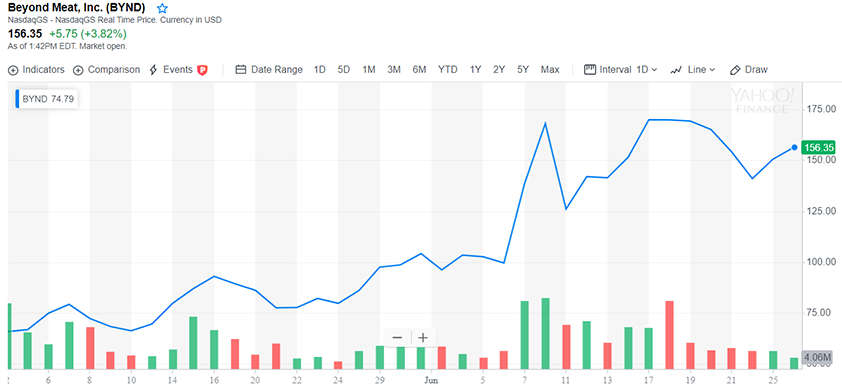
Source: Yahoo Finance
Is Beyond Meat really immune to competition?
Beyond Meat now has a market value of around $USD 10 Billion. By comparison, the largest US meat processing company, Tyson Foods has a market value of around $USD 29 Billion and has been operating since 1935. In an ironic twist of fate, Tyson Foods was an early investor in Beyond Meat with a 6.5% ownership stake before it went public. However, Tyson sold its stake when competitive tensions arose from the fact that Tyson was planning its own line of meat-free products. Had Tyson held its stock through the IPO and continued to own it, its stake would be worth around $650 million at the current BYND stock price.
Other companies, like Burger King, are taking their own path and have announced that they are partnering with Beyond Meat’s main competitor ‘Impossible Foods’ to launch a competing ‘Impossible Whopper’. Loblaws ‘President’s Choice’ brand recently launched its own copycat version called the ‘Undeniable Burger’ with a nearly identical ingredient list to Beyond Meat’s burgers. McDonald’s sold a veggie burger in the past, but discontinued it due to poor sales. They have yet to jump back into the veggie or meat-less burger game, but I’m sure if McDonalds starts losing market share to competitors selling non meat burgers, they will be back in the fray.
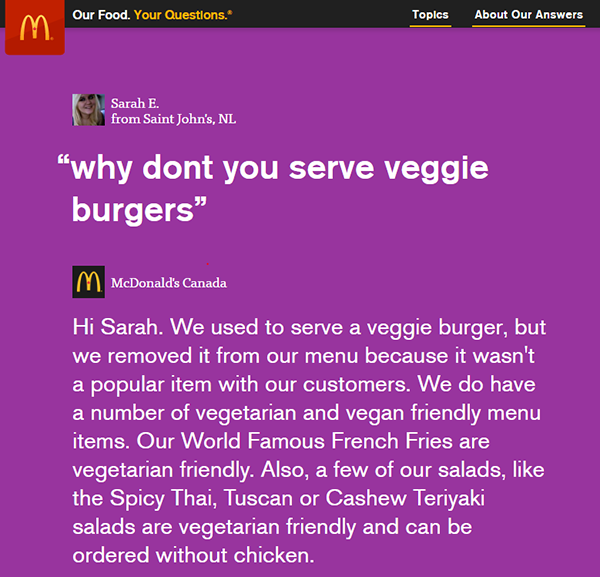
Source: Mcdonalds.com/ca
In my limited personal experience with veggie burgers over the years, I have always been left unsatisfied with the patties. Veggie burgers have been around for decades but have mostly been crafted to simply taste like the vegetables, grains or soy components that they are made of. My solution when eating a veggie burger was to add copious amounts of cheese, ketchup, mustard, pickles, tomatoes to the point where the toppings ratio exceeds the burger ratio to provide an adequate ‘burger experience’ and mask the otherwise bland taste of the meatless burger patty.
Is the point to have a burger that tastes like real meat or simply tastes good on its own as a non-meat alternative?
It seems that the current fuss over the Beyond Meat products is that they taste and cook more like real meat than any other meat alternative product currently available. As a native Albertan and lifelong meat eater, I have a hard time giving up on the occasional indulgence of a good ribeye steak or juicy burger. (Early readers may recall that one of my first blogs was about using technology to cook the perfect steak…Click Here) For carnivores like me, having the sensation of biting into the real thing is a positive feature. Beyond Meat’s latest version of its burger patty is advertised as being ‘Even Meatier’ and claims to have authentic meat-like marbling through the clever use of pockets of coconut oil and cacao. For long-time vegetarians or vegans this sensation may be off-putting as they may not want it to taste or look like meat at all.
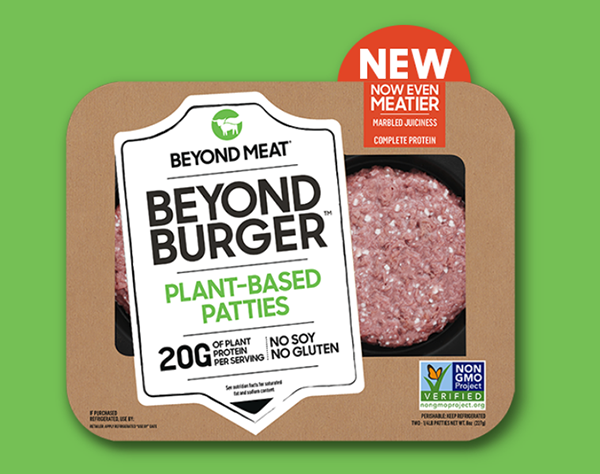
Source: www.BeyondMeat.com
Going vegetarian or reducing meat consumption has long been touted as a healthier diet, less expensive and better for the planet. Meat production is a messy and resource intensive business and meat is generally one of the more expensive parts of a meal, so I was surprised to see that Beyond Meat’s products sell for a significant premium to real meat burgers. A package of two Beyond Meat burger patties sells for around $8 at my local grocery store. Comparing to other frozen burger patties, for example: ‘President’s Choice - Angus Burger’ sells a package of eight patties for around $10. This works out to about $4 per patty for Beyond Meat and $1.25 per patty for the PC Angus burger patties made from real beef.
Beyond Meat’s products are priced like a luxury good and clearly not a cheaper alternative to eating meat. I ran a simple calculation and the cost of a ribeye steak from AAA Alberta beef is about the same price per pound (~$18/lb or roughly $40/kg) as a Beyond Meat Burger patty. Perhaps this is part of the brand’s cachet and source of the market’s excitement. It is a well-known marketing tactic that people often think expensive things must be better. Beyond is building a product out of widely available commodity ingredients (like pea protein, beet juice and other simple ingredients) and turning it into a premium product at a premium price. It appears that they are taking a page out of Apple’s playbook for products and market placement. There is nothing remarkable about the electronic chips inside an iPhone or MacBook compared to other phones or laptops, but Apple can charge a premium price for a product that is seen as unique and better quality. Apple currently captures about 15% of smartphone sales, but routinely takes in over 80% of smartphone profits globally and is one of the largest and most profitable companies in the world today. Selling a differentiated product with 40% or 50% margins is clearly a more profitable business model than selling a commodity product with low margins, if you can pull it off year over year.
Having never tried Beyond Meat’s products, I was keen to taste them for myself to see what all the fuss is about. To avoid too much personal bias, I also thought it would be fun to test them out on my friends to get their feedback in a blind taste-test comparison.
So how do they stack up? My first stop was to take a trip to A&W to test out their version of the Beyond Meat burger and compare it to their classic ‘Teen Burger’, as A&W was the first fast food chain in Canada to offer the product on their menu. I had to remove the bacon from the Teen Burger to make a fair comparison, as comparing a beef burger with bacon puts the fake meat burger without bacon at an obvious disadvantage (for my tastes anyway!). Bacon removed, the burgers are nearly identical in terms of toppings and condiments. The burgers were disguised, and I took a bite of each one without knowing which was which. I could tell that the Beyond Meat burger patty wasn’t real meat in a direct side-by-side comparison to the beef burger, but if someone had swapped out my burger patty without telling me on another day, I probably wouldn’t have noticed right away.
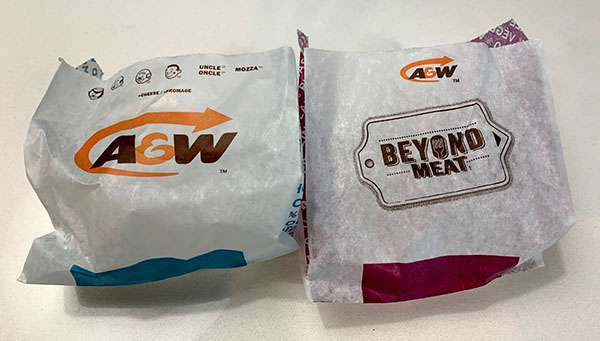
Source: my iPhoneX
Can you tell the difference?
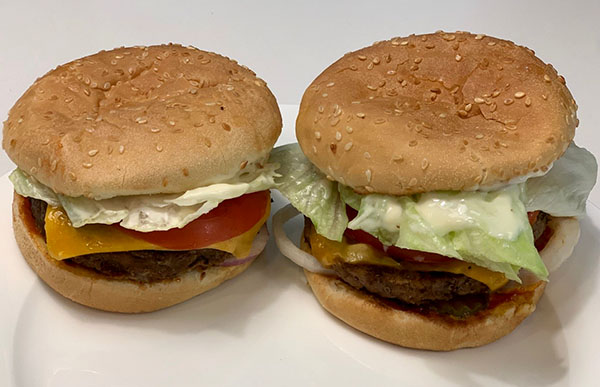
Source: my iPhoneX

Source: my partner's iPhoneX
The blind taste test compared the following products to evaluate different types of meatless burgers compared to a real meat burger as a control group:
- PC Angus beef burgers – Beef that is ‘Free From Antibiotics and Hormones’
- Beyond Meat - Beyond Burger (Pea Protein, beets, Mung beans among other things)
- PC Beefless ‘Undeniable’ Burger (Pea protein and beets – similar to Beyond Meat’s ingredient list)
- PC ‘The World’s Best’ Meatless Burger (Soy and onions)
- Amy’s Organic ‘Sonoma’ Veggie Burger (Quinoa, Carrots and Walnuts)
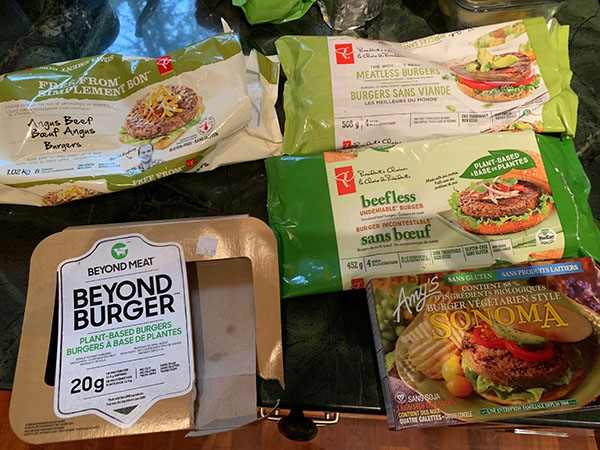
Source: my iPhoneX
Which is which?

Source: my iPhoneX
The burgers were all cooked on the same grill at the same time and served fresh off the grill. Interestingly the Beyond Meat burgers cooked in a similar way to the real beef burgers. As the patties cooked, they released red liquid and crisped up on the outside in an eerily similar way to real beef patties. By comparison Amy’s Organic Sonoma burgers simply dried out and charred on the outside.
My cohort of friends that I subjected to this test to was mostly composed of cyclists ranging in age from around 30 to 50 and the split was roughly 50/50 male and female. There were no vegetarians in the group, so everyone participating had a sample of the beef burger to compare against. About half of the group had also just completed a two-and-a-half-hour bike ride, so the hunger level was relatively high. To simulate a realistic backyard BBQ environment where this type of burger is most likely to be served, there may have been some beer and chips served prior to the test.
Participants in the blind taste-test were provided a bite size sample of each patty on a piece of bun in random order and asked to dress it to their taste (add ketchup, mustard etc each time as they normally prefer). In order to try and isolate the meat substitute question versus something that simply tastes good for what it is, the following questions were asked:
- “How confident are you that this is meat?” (0 is definitely plant and 10 is definitely meat)
- “Regardless of whether you think this is meat or not, does it taste good? (0 is gross and 10 is yummy)
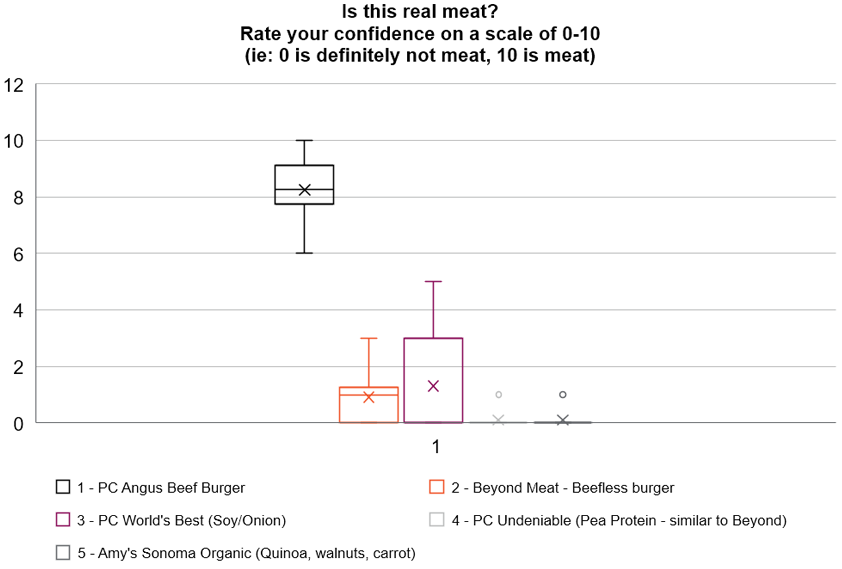
Most people could tell that the real meat burger patty was in fact made of meat and that the meat-less burgers were not. However, a few people were less than confident that the real meat burger patty was in fact real meat. The PC ‘World’s Best’ and Beyond Meat ‘Beyond burger’ also had a few people fooled.
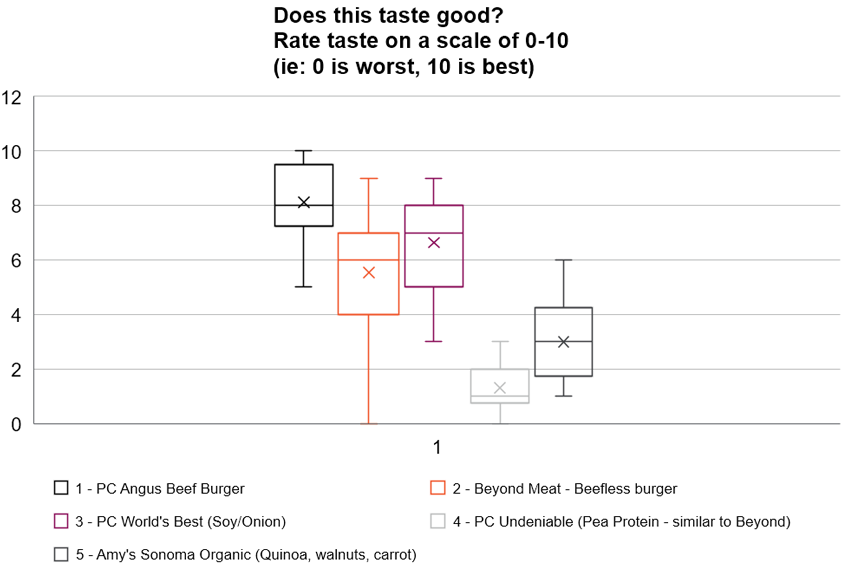
The results from the burger taste test revealed some interesting findings. The real meat control group (PC Angus) had the best score on taste overall. The Beyond Meat burger scored third in the taste test with the PC ‘Worlds Best’ burger edging it out by a small margin on average. The group was the most divided on the Beyond Meat patty, with one tester giving it a 9/10 while another gave it a 0/10. The President’s Choice ‘Undeniable’ copycat of the Beyond Meat burger (at least in terms of the ingredient list) received the worst rating among the group. In second last place was the Amy’s Sonoma Organic patty. This burger is clearly not designed to emulate meat at all. Some testers had comments like: “this tastes like sawdust” but others seemed to appreciate that it tasted like its vegetable and grain ingredients.
The conclusion that I can draw from this sample size of 5 different burgers on 12 people is that if a meatless burger is designed to emulate meat, it needs to be as close as possible to the real thing. If the attempt at being meat like is off, then it falls into the in-between world of neither being a good simulation of meat or a good tasting veggie burger. This seemed to be the case with the President’s Choice attempt to copy Beyond Meat’s recipe. Most participants felt that the PC ‘Undeniable’ beefless burger was ‘Undeniably’ bad. I suspect that the results would have been much different if the test was done on a crowd of vegetarians, who may be looking for different attributes for their ideal burger than a perfect simulation of meat.
Can Beyond Meat keep the momentum and sales growth that it has seen in the last few years?
The company is building a solid brand and has a market lead in this quickly evolving space. However, staying ahead of well-funded and capable competitors is a tough game in the long term. If Beyond Meat can become a household name, like Heinz Ketchup or Coca-Cola, and keep selling their products at a premium price with high margins, perhaps the current market valuation is justified. If competitors come in with similar or better products at a lower price, then their market lead will likely be eroded. I don’t know what the future will hold for Beyond Meat, but as a lifelong meat-eater, I have to applaud their efforts in creating a tasty burger that does a good job of emulating real meat. (To be clear, none of this blog is intended to be a stock recommendation one way or another, I’m simply trying to find out what all of the fuss is about. Speak with your advisor, do your own research and make an informed investment decision.)
Another trend that is seen as the future of the meatless meat game is the creation of fake meat that is grown in a lab using cultured meat cells. This sounds like science fiction, but a few companies are working hard at commercializing the technology. There may come a time where they are able to create a burger or steak that is even juicier and tastier than the real thing, without using live animals as their source. Perhaps this will be the topic of the next taste test and blog when this type of product hits store shelves.
The opinions expressed in this report are the opinions of the author and readers should not assume they reflect the opinions or recommendations of Richardson GMP Limited or its affiliates.Richardson GMP Limited, Member Canadian Investor Protection Fund. Richardson is a trade-mark of James Richardson & Sons, Limited. GMP is a registered trade-mark of GMP Securities L.P. Both used under license by Richardson GMP Limited.
All photo credits to the Author unless otherwise noted.